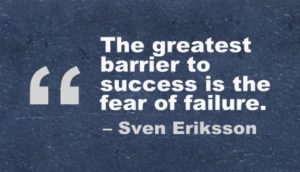Whether you are looking to certify, enter a grooming competition, or other highly visible display, the seasoned pros seem to have total control over their situation: calm, cool, and collected in their thoughts.
 Looks, however, can be deceiving. Beneath the surface of total control, even the most seasoned, show-savvy competitors get butterflies in their stomachs. They experience the same sort of show jitters and performance anxiety that plagues those who compete at lower levels. But seasoned stylists eventually learn to use those gut-churning sensations to their advantage. They productively channel their nervous energy rather that allow negative thoughts and feelings to overwhelm them and interfere with their performance.
Looks, however, can be deceiving. Beneath the surface of total control, even the most seasoned, show-savvy competitors get butterflies in their stomachs. They experience the same sort of show jitters and performance anxiety that plagues those who compete at lower levels. But seasoned stylists eventually learn to use those gut-churning sensations to their advantage. They productively channel their nervous energy rather that allow negative thoughts and feelings to overwhelm them and interfere with their performance.
Everyone gets nervous – it’s normal. Even the elite in the pet styling world become nervous but they learn to work with it. You have to train yourself to like the feeling and see it as an asset.
Performance anxiety reveals itself in many forms:
- stomach misery
- sweating
- shortness of breath
- fidgeting
- tension throughout the body
- chattiness
- uncharacteristic silence
Some stylists are wracked with anxiety from the moment they wake up the day of the competition or certification, others get a burst of butterflies just before entering the stage.
 No matter how or when performance anxiety occurs, it usually is fueled by the fear of failure. Many stylists place great pressure on themselves to do well. Others feel compelled to do everything in their power not to disappoint their employers, fellow staff members, or family members. Those who enter the contest arena or testing site with a client dog have the added responsibility to do a good job to please the owner. Some groomers are deathly afraid of embarrassing themselves in front of an audience.
No matter how or when performance anxiety occurs, it usually is fueled by the fear of failure. Many stylists place great pressure on themselves to do well. Others feel compelled to do everything in their power not to disappoint their employers, fellow staff members, or family members. Those who enter the contest arena or testing site with a client dog have the added responsibility to do a good job to please the owner. Some groomers are deathly afraid of embarrassing themselves in front of an audience.
To a certain degree, many people are predisposed to being overly anxious. It’s a part of their persona and temperament, just as some folks are normally laid-back or unflappable.
Actually there’s little difference physiologically between excitement and fear. While one person says, “Oh boy, here I go!” the next person is saying “Oh no, here it comes again.” The feelings are much the same. The difference is that one is positive while the other is negative.
Those who work through anxiety may be nervous prior to performing, but they are able to set aside the negative feelings and focus on the skills they need when it’s time to compete or start testing. In contrast, stylists who can’t get past their nervousness extract less and less pleasure from competing or testing. Worse still, performance anxiety can crush confidence and divert attention for completing the familiar steps of an established trim, which reinforces the feeling of being unprepared.
 Because dogs are highly attuned to our feelings, they can sense when something is amiss with a groomer’s emotions. Although some dogs are not rattled by what they sense from their handlers, others become increasingly anxious, especially when they are already distracted by the sights and sounds of unfamiliar surroundings.
Because dogs are highly attuned to our feelings, they can sense when something is amiss with a groomer’s emotions. Although some dogs are not rattled by what they sense from their handlers, others become increasingly anxious, especially when they are already distracted by the sights and sounds of unfamiliar surroundings.
- Set Yourself Up to Succeed
Select a good dog you feel comfortable working with, choose a trim you are familiar with, and study high quality reference material. - Know More Than Enough
You’ll be more likely to succeed when you start at lower level that’s less challenging than what you are accustomed to at home, whether that means choosing a simple trim to execute, a smaller dog to work on, or a better coat to scissor. Everything you do should be easier, not more difficult, when you’re in a show or testing atmosphere: that’s what builds confidence. - Have a Dress Rehearsal
Attend small clinics or go to a trade show or conformation dog show and hire a seasoned competitor to be your coach. Videotaping yourself adhering to the time restraints of typical grooming class is highly beneficial as well. - Get Focused
To heighten awareness of the specific challenges that lie ahead, plan your trimming process on the dog. Dissect the time you have allotted for each area of the dog, visualize the finished profile you want to create – see the velvet scissor finish. Think through the entire haircut, don’t just start whacking off hair and hope for a positive outcome. - Be Positive
Negative thoughts take a toll on your mood as well as your confidence, and they can inadvertently slip you up at an inopportune moment. Concentrate on modifying your thoughts in a positive tone. Remind yourself to keep your shoulders relaxed, your hand smooth and steady, and move with your hips and knees when you are scissoring. - Visualize Success
Imagery is more powerful than internal dialog or self-statements when it comes to helping a person access his or her internal resources. For that perfectly scissored coat, think of crushed velvet. Or visualize a photo or a drawing of the perfect dog you want to create. Close your eyes and take deep breaths envisioning the image perfectly in your mind. Focus on a positive image rather than thinking about failure or a disaster. - Take a Break
When all your preparations are accomplished – your dog is bathed and fluffed, you’re dressed to step into the ring, your tools are in order – give yourself a break from the hustle and bustle of the competitive environment and take a few moments to gather your thoughts. - Be Kind to Yourself
Everyone wants to win but facts are facts and the placements only go so high. When I would head to the ring, I always wanted to give my best performance, but I’d play a mind-game with myself too; I would say to myself “Melissa, what’s the worst thing that could happen?” The answer was always, “I could be out of the placements with my dog. I’ve dealt with a lot worse…” One of the best learning tools you’ll ever get is personal critiques from seasoned pros. The grooming tips you can pick up at a show are invaluable to your career as you gain grooming knowledge.
Feeling you can compete with confidence allows you to enjoy the experience. You may always have to work at managing your nerves, but as your self-assurance grows and you learn to channel your thoughts productively into your performance, your anxiety will dissipate. And when you’re done competing, you may even think, “That really wasn’t so bad after all.”
Get used to your anxiety. Don’t be rattled by the way it makes you feel. Embrace it and eventually you’ll discover how to use it to put your best foot forward in every competition.
How do YOU beat the butterflies? Jump over to the Learn2GroomDogs Facebook page and tell us about it!
Happy Trimming!
~ Melissa

